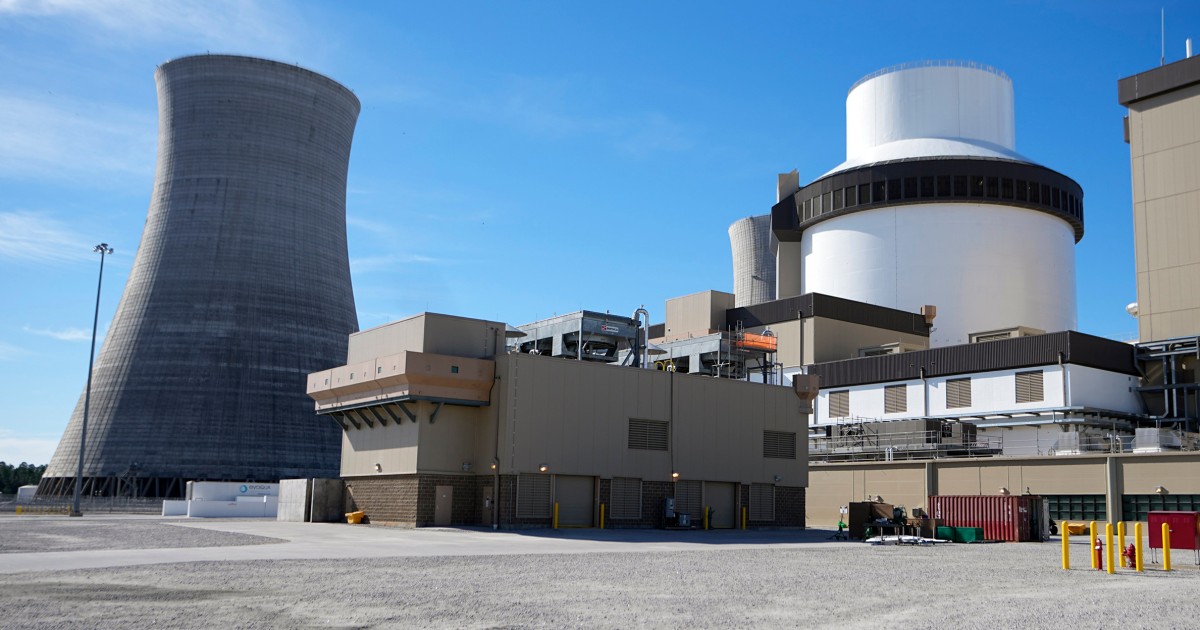First U.S. nuclear reactor built from scratch in decades enters commercial operation in Georgia::ATLANTA — A new reactor at a nuclear power plant in Georgia has entered commercial operation, becoming the first new American reactor built from scratch in decades.
I highly, highly recommend the Oliver Stone documentary Nuclear Now from earlier this year. Completely changed my perspective. I had no idea that the oil industry was behind so much of the fear mongering around nuclear.
To be fair we have seen multiple disasters in the past including Chernobyl, Three Mile Island, and Fukushima, which have serious and long lasting effects. I’m not against nuclear power but we can’t pretend the downsides are just made up or blown out of proportion.
They are sort of blown out of proportion when you take into account modern safety protocols.
Chernobyl and three mile island were user error, fukushima was force majeure.
Since then they’ve been piloted widely. France has about 50 reactors and a laundry list of smaller errors that we’ve since learned from.
Have you ever compared the impact of Fukushima compared to the tsunami that caused it?
Other than that, even if we assume rectors keep being old tech from the 60s, never using newer generations of rectors that can be inherently safe: Who cares about a bit of contaminated area, very localized, every few dozen years, when the alternative is a global climate crisis?
More people died in the evacuation of Fukushima than died fighting the meltdown, which was arguably 1.
1 confirmed from radiation (lung cancer, 4 years later),[3] and 2,202 from evacuation.[4]
The tsunami killed over 15,000 people. Awful disaster.
However, Japanese people are very anti-nuclear so their media made it seem that the impact was horrific when, aside from the exclusion zone, wasn’t all THAT bad. However, losing that land was a big hit to a small country.
I’d agree if our only two options were nuclear or coal/oil plants but we have many options that don’t require everything be powered from centralized power plants.
Who cares about a bit of contaminated area, very localized, every few dozen years, when the alternative is a global climate crisis?
I’m sure all the people and companies that exist in these areas. Land is finite and hospitable land is even more finite. Destroying these areas for decades to come isn’t any more preferable that the occasional natural disaster rolling through over a few day period.
As I said I’m not against nuclear power and I would love to see more advancements come to fruition, but it doesn’t need to be our main source of energy nor is it accurate to claim that the potential issues that come with it are solely overblown conspiracy theories pushed by oil/coal companies.
I mean, it’s obvious.
Also historically some of Soviet-friendly left would present “capitalist” nuclear energy as apocalyptic-level dangerous and related to nuclear weaponry etc (cause USSR was, after discovery of reserves, selling oil and gas just like Russia does now, actually that was the reason for Brezhnev’s time improvement in level of life and simultaneously rapid growth of corruption, also loss of hope of anything like the Thaw happening again).
Or, maybe people recognize that literally the majority of radioactive mining leaves irradiated lands that disproportionately effect minorities and oppressed communities. The Navajo are still suffering due to the mining of radioactives in their area. The same story is true for nearly every community near such facilities.
while that is certainly an issue, i very much doubt that it is a primary reason (or even remotely a concern) for the average anti-nuclear layperson.
Ah, those activists wouldn’t talk about that mostly, they’d talk about boom and radioactive pollution in places their audience lived in.
Leftists caring about minorities and oppressed communities anyplace far from themselves are a notable rarity.
And since the replacements were coal, oil and gas, which are just as dirty, I’d say your argument isn’t worth shit.
That’s funny.
So you’re willing to move within 1 mile of a uranium mine and live there and drink the well water from that property?
Or are you just willing to sacrifice others for your luxurious lifestyle?
There are alternatives other than continuing to expand our consumption of fossil or nuclear fuels. Hell, most of them don’t even require lifestyle changes from the majority of the population.
So you’re willing to move within 1 mile of a uranium mine and live there and drink the well water from that property?
No, but it’s the same with gold mines, copper mines, coal, ohoho, oil, ahaha, etc. Scale matters, and in scale for the same amount of energy nuclear gives the least pollution.
Also I invite you to live near a lithium mine.
Or check it, we don’t increase our consumption, so we don’t need more energy. We purposefully decrease it. We allocate resources by necessity.
Widget factories don’t need to operate 24 hours a day, and their owners don’t need to make 500x their employees wages. Kill two birds with one stone, the widget factory is only allocated enough energy to run a few hours a day, and the wages from its executives (who have proven they don’t deserve it by the very lack of care towards sustainability they have presented) go to the workers to ensure they continue to make the same amount despite the decrease in work time.
You do that with all of the industries in the world, and I guarantee we could cut emissions by 50% within a year. Obviously, global implementations are much more complicated than my comment would imply, but I think accepting an end to a system where the only limits placed upon industry is “how much money do you have?” Is necessary entirely to have even a fraction of a chance at beating climate change.
Then, once we’ve stopped wasting massive amounts of energy on inherently useless endeavors, then we can start to talk about the pollution caused by nuclear, but until then, it’s just replacing one extractive industry with another. Whether or not in theory nuclear is less damaging environmentally, our current Money = Right system precludes the possibility of such sustainable practices being put into place. There is always another country that can be corrupted to allow destructive, cheap extraction processes, like what happens in Mail, Burkina Faso, and Niger as we speak.
Very good news. Nuclear power simply has way more benefits over fossil fuels. Not to mention it’s statistically safer, despite what decades of anti-nuclear sentiment has taught the public.
It’s pronounced NOOK-YOU-LERRR
I’m all for investing in other forms of energy beyond fossil fuels, this is good news to me.
Good news. Anything but fossil fuels at this point.
Nuclear is still fossil fuel, just not combustion. But I agree, this is good news because it helps reduce coal and gas usage.
Edit: I get it, I’m wrong. No need to repeat the same comments over and over.
Nuclear is Non-renewable, but it’s not a Fossil fuel:
A hydrocarbon-based fuel, such as petroleum, coal, or natural gas, derived from living matter of a previous geologic time.
We have plenty of nuclear fuel and waste is a drop in an ocean compared to that of fossil fuels.
Yep. This is why I’m annoyed the UK is dumping its money into oil and coal fuel sources. We need more Nuclear plants and we should have started building these yesterday.
The best time to
plant a treebuild a nuclear power plant was 20 years ago. The second best time is now.
The reduced operating emissions take 10+ years to outweigh the enormous construction emissions of nuclear. (Compared to gas.)
Fortunately the nuclear reactor can be operated for >50 years :)
Sure. But do you think Nuclear reactors will still be cheaper than renewables + storage in the 2070s? Nuclear is far more expensive per kWh than renewables, and the cost of storage is falling fast.
Good question, that one can only speculate on. IMO it’s a two part question.
First is that newly built nuclear plants are expensive. So the question depends on if we bite the bullet (build the reactor) today or in 2070. One built today will produce cheap power in 50 years.
For example in Finland we have reactors from 1980, that make up the backbone of stable energy production in our country. Those are going to be kept online till the 2050s. I’d argue at that point the cost per kwh will be mostly dependent on maintenance and fuel, so relatively small.
Wind and solar cannot reap the same benefits if you have to replace the plant every 20 years.
Storage is a completely separate question that is not taken into account when new wind farms and such are being built. If one was to account for storage today, the cost of renewables would be much closer to that of other means of production.
Also in the future, if storage costs keep falling due to billions of R&D money, similar effects could be achieved in nuclear via serial production and scale.
EDIT: Just read you have studied this stuff for real. Then ignore most of what I said, as you might know better :D
The cost of the power it generates in 50 years aren’t lower than the day it opens. If you amortise the cost of the plant over its life nuclear is stupid expensive per watt produced. It’s expensive enough that renewables + storage is cheaper. Renewables + storage is also a lot quicker to build than nuclear.
Even after the uptick in cost of renewables in the last year (which was dramatic) they’re still the cheapest new build power (even accounting for the integration costs). As an example here’s the most recent annual csiro report on energy costs by type. It doesn’t include full scale nuclear today because it’s known to be unviable, but even 2030 projections on “if smrs are commonly deployed at scale” they’re predicted to be a lot more expensive than renewables with integration costs.
https://www.csiro.au/en/research/technology-space/energy/energy-data-modelling/gencost
It was started a decade ago and finished now, not in the 2070s
Mean and median lifetime of a nuclear reactor is well under 30 years. Closer to 20 if you count all the ones that produced for 0 years.
So you’re saying the construction effort requires at least a decade of nuclear powered energy to be achieved?
That could be up to 3.652 TWh. That’s more than my entire nation consumes in three years and we’re one of the world’s biggest suppliers of natural resources, including nuclear.
You’re mathing wrong.
deleted by creator
I literally studied this exact nuclear design at University - the Westinghouse AP1000. You can look up the WNISR (World Nuclear Industry Status Report) if you don’t want to take my word for it.
Don’t forget, mining and enriching uranium still has a significant carbon footprint, far higher per tonne than any fossil fuel. Yes, it’s lower over time, but we need to be reducing emissions now, not in 50 years time.
Why compare per ton of fuel when per kWh would be the more meaningful metric?
What are the cradle-to-grave emissions of a nuclear plant, vs a fossil fuel plant, per kWh generated. That is a far more honest question, and I’m inclined to err on the side of nuclear.
Let’s not forget radiation caused by the power plant. Nuclear produces far less radiation than a coal plant.
deleted by creator
Why are you comparing fossil fuels and nuclear “per tonne” that makes no sense. You replace tens of tones of nuclear fuel per year any you burn millions of tones in a comparable fosil fuel plant.
And regarding the carbon emissions from enrichment… Just use nuclear to power your enrichment plants. This way your emissions are extremely low because you don’t need much fuel and you use nuclear energy to produce nuclear fuel. French example: https://en.m.wikipedia.org/wiki/Tricastin_Nuclear_Power_Plant
Yeah I hate how laxness about fixing this in a timely manner has somehow convinced some people that shit like “carbon nuetral by 2070” is ok and helpful. And I’m just remembering when that study came out that said the climate as we know it is probably gone forever if we aren’t totally carbon nuetral by at least 2030
Hey wow, it’s great to see we are still persuing this avenue for energy, I hate how stigmatized nuclear became (with some good reasons). Like any technology, we just rushed to using it without understanding the full consequences when shit goes wrong. Hopefully we’re better prepared now.
Ooh a lot of people here seem very pro-nuclear-power. That’s cool!
Unfortunately, there’s still that one guy in the comments trying to say that hypothetical, largely unproven solutions are better for baseload than something that’s worked for decades.
That or the fear-mongering talking points. That’s what caused our local power plant to be decommissioned, and now those same people are complaining about how much their electrics cost now.
The old soviet legacy. And a bit of actual disasters and from the 2 significant ones (hiroshima and chernobyl) half are beacuse of the soviets.
*Fukushima
Hiroshima was the freedom bombing disaster
on a side notw how people have dies from fukushima in the years since and how many have died from coal? Also you can compare the number of long term health problems
If you mean renewables by that, it’s hardly hypothetical or unproven. I’m in Australia and south Australia and Tasmania (two of our states) have fully renewable grids, Tasmania for the past 7 years. South Australia does still occasionally pull from an interconnect but most of the time they’re exporting a bunch of power.
Renewables with storage are cheaper and faster to build than nuclear and that’s from real world costs. Nuclear would be fine if it wasn’t so stupidly expensive.
Tasmania
Generates nearly all its power using hydro electric, which is great but pretty dependent on geography.
South Australia
Wiki says a pretty big hunk of that is still gas
In Ontario Canada where I am from it would take > 4000 wind turbines all working at once (not including the batteries) to supplant our nuclear capacity. Even the largest battery storage are in the hundreds of mega watts and only for a few hours at the cost of about half a billion dollars.
I think it is more productive to approach these technologies as complementary as any proper grid should have both for the near future if we want to reduce global warming.
Ah sorry, my mistake on that one. Despite how many wind turbines working at once it may take, the power from the is cheaper by a long shot than nuclear.
The reason I don’t think nuclear is the main solution is just cost + build time. It’s horrendously expensive. Much more so than the cost of renewables with proper grid integration (transmission, storage etc.) that has been modelled.
Maybe in a while the small nuclear reactors may come close, but currently the full sized reactors are too expensive and smr’s aren’t really a thing yet because of cost.
If power prices can come down instead of go up it’s going to be a lot easier to convince everyone to transition away from fossil fuels, and from modelling that’s been done (e.g. by csiro) that can be the reality
South Australia is 70% renewables, as per their own official energy site.
Batteries are the limiting factor for renewables. Building battery storage that can supply a large city is expensive. Even the battery South Australia had Elon Musk build can only supply a town for about an hour. I’m hoping battery tech improves soon, but it seems to have stagnated for a while.
Ah sorry, my mistake. I messed up there.
The battery in SA is really just for grid stabilisation, not long term storage. Batteries are not really a good soln for longer duration storage. You need surprisingly little storage though when they’ve modelled fully renewable grids which is why the projected costs aren’t stupidly expensive.
That’s interesting, I’m an EE but in industry atm. I’d like to look into that whole scenario one day and see how much storage we’d need to go fully renewable.
I think you mean hypothetical technology that hasn’t been invented yet, but he expected will be in widespread use 50 years from now.
The nuclear lobby is alive and well on social media. Never before has the internet apparently agreed on something so controversial with some of the most cookie cutter, copy and paste, AI generated comments on the subject I’ve ever seen.
The talking points seem to gloss over the fact that nuclear storage always fails, meltdowns happen, and you still have to mine uranium out of the ground. It’s far from a clean source of energy.
That the “nuclear lobby” is paying people to post stuff on Lemmy, a social media platform that accounts for a small part of single percent of all social media users, is a hot take I haven’t heard yet. Congrats, you’ve definitely imagined a scenario that nobody else in history has ever thought of. A true original thought.
Pity it’s an absolutely fucking brain dead take masquerading as something more than nonsensical blithering from a total nincompoop, but you should bask in this moment nonetheless.
Nuclear power is something we should be using if you support science. If you don’t support science well you have a lot of other problems. Nuclear and renewable energy both need massive investments at the same time to replace fossil fuels.
It’s not the cleanest, but in term of CO2 and other toxics produced per Giga-Watts, it’s the best compromise.
Fission is hopefully, coming in the next decades. Like the other guy said, anything but coal/petrol.
Wait… is this the USA’s first Gen III+ reactor?
It looks like it!
Looks like the only completed Gen 3 nuclear reactors are in Asia, at Kashiwazaki (Japan), Kori (South Korea), Yangjiang, Fangchenggang, Tianwan (China), and Kudankulam (India).
Edit: I missed the Gen III+ part of that Wikipedia page. The other currently operation or under construction Gen 3+ reactors are in Sanmen, Shidao Bay, Taishan (China), Novovoronezh II, Leningrad II, Kursk (Russia), Akkuyu (Turkey), Rooppur (Bangladesh).
Not sure, this isn’t super easy to research, but an identical reactor is being built along side this one, so if it is our only 3+ it hopefully won’t be for long
Good to see industrial self sufficiency coming back to the US
Yeah, after literally bankrupting Westinghouse and costing us Georgians billions of dollars. I’m all for more nuclear power but this project was a colossal shitshow.
Georgia also has some shiny new solar factories so I’m interested to see how deep into renewables we can get in the next decade.
Outstanding!
Goated energy source, hope the stigma lessens over time
Not sure the stigma will ever go away as long as we are using Uranium as the basis. If we could ever get Thorium based reactors to work and economical I think the public perception would sway considerably when weapon grade material is no longer a possibly byproduct and the worst case scenario drops from a quarantine zone several square miles to power plant just going into lockdown for a few weeks would be a huge step towards public acceptance.
I think the public perception would sway considerably when weapon grade material is no longer a possibly byproduct
This is unfortunately something that a layperson who’s unfamiliar with the tech will always have a hard time understanding. I don’t think any reactor built in the US for power generation could ever be used to make weapons grade plutonium. From what I’ve read we only build light water reactors here, which aren’t good for such things. But how many regular folks take the time to learn about all the different types of reactors and how they work and what they’re good for? I only did it because the history of nuclear tech intrigues me.
and the worst case scenario drops from a quarantine zone several square miles to power plant just going into lockdown for a few weeks
Similar to above. These new reactors coming online are Gen III reactors, and have passive cooling features, so Fukushima-like events shouldn’t be able to happen anymore. But again, few people I think take the time to learn about this stuff at all.
It doesn’t help either that regulatory capture has caused old Gen II designs without the passive cooling backups continue to get their licenses extended. Accidents will continue to be bad until we retire the ancient reactors, and start replacing the with new ones that have the benefit of half a century of operational experience and manufacturing advancements to inform their designs to be safer.
With today’s contractors? Good luck with that.
At this time of year? Localized entirely in your kitchen?
Can I have a look?
No.
The nameplate cost of this plant is $32 per watt. Even at smaller scales, utility-scale solar plants are $1 per watt. Do you know how many grid storage batteries you could buy with the extra $31 per watt? (6 hour storage is around $2.50 per watt or $.40/Wh.) You could build a solar plant 4x the nameplate capacity of the nuke (in order to match the capacity factor), and add 24 hours of storage to make it fully dispatchable, and still have enough money left over to build 2 more of the same thing. This doesn’t even include the fact the nuclear has fuel costs, waste disposal, higher continued operational costs, and unaccounted publicly involuntarily subsidized disaster insurance.
Even at smaller scales, utility-scale solar plants are $1 per watt.
Solar is being built at 100% speed. We’re utilizing all the solar panel manufacturing capacity in the world building and deploying solar right now. There’s simply not enough rare earth metals to increase production more. Wind, Hydro, Nuclear and Geothermal are all needed of we want to replace coal and LNG power plants.
oyo
You can build entirely new solar supply chains from mining through manufacturing faster than a single new nuclear plant.
But solar panels take up a lot more space for the energy they give out than a nuclear plant iirc
But solar panels take up a lot more space for the energy they give out than a nuclear plant iirc
But it’s not like we need to pave over pristine wilderness to build out solar: it’s easy to deploy rooftop solar on tens of thousands of square miles of rooftop surface, or on top of tens of thousands of square miles of area that has already been sealed for parking lots while simultaneously providing shade and protection for parked cars.
And we could do all of that at a fraction of the cost of building new nuclear power plants.
I think a nuclear would be better in the short term. But I agree that we should have a lot more solar etc. But its up to the individual home owner so not much we can do there. But as transitional energy nuclear is the best option imo. Plus theres days without sun, wind or whatever else. So those days youd need a reserve or some other way to get energy
i mean if you mix them all together and use land area for geothermal and solar or nuclear and solar you kinda fix the issue because solar’s issue is it takes up space but it can go in the same place as another thing like wind or nuclear or geothermal or hydro but it doesn’t work the other way too well, you can’t have wind efficiently at a nuclear place all the time, nor can you do geothermal at every nuclear plant or hydro
so tl;dr solar is useful for combined energy sources on already used land areas but otherwise its kinda dumb as a primary energy source so is wind on land for other reasons but if you combined wave or other hydro, wind, and solar all together it’d be great though idk how good that’d be for the ocean cuz you’re occluding sunlight
its a whole intricate balance tbh
Not only is the amount of land required insignificant, and optional (agrivoltaics and built up areas are capable of providing enough for marginally higher labour cost). Low yield uranium mines like Inkai (so most of them going forward) take up more space than a solar farm with the same energy output because the ore has lower energy density than coal.
If you’re going to pearl clutch about land use, pearl clutch about the idea of developing any of the 90% of Uranium resource that has abysmal yield.
As far as space is concerned, we have plenty of square footage for panels on the roof of every building/structure.
Some places are requiring solar to be installed on new construction which does increase cost but will pay off as installs become more ubiquitous.
That probably depends on how well connected and moneyed you are. Though, in fairness, it took nearly 15 years for this reactor to come online.
Speaking of geothermal did you hear about the brrak through in drilling using mocrowaves. It radially speeds up driving
I didn’t, have a link?
Here is an alternative Piped link(s): https://piped.video/watch?v=g8sjdOjNxIE
Piped is a privacy-respecting open-source alternative frontend to YouTube.
I’m open-source, check me out at GitHub.
Monocrystalline solar doesn’t involve rare earths at all, idiot.
If you want to pearl clutch about them, pearl clutch about gadolinium in nuclear plants.
They aren’t pearl clutching, they’re stating the obvious fact that humanity is pumping out solar panels as fast as macroeconomic (or perhaps geographic) forces will allow.
Monocrystalline panels take quite a lot of pure silicon, which may not technically be rare earth, but it is in quite high demand right now.
This is even more ridiculous.
It’s sand. Literally the most abundant element in earth’s crust. And quartz sand isn’t even as particular as construction sand, because only the composition is important, not the shape.
You’re literally pearl clutching about the scarcity of Silicon as a way of justifying calling it a rare earth.
The only limitation is manufacturing, and you can build manufacturing and the output faster than you can build a nuclear reactor. You’re also comparing an industry that’s adding >300TWh/yr to one that is adding zero net (and about 20TWh/yr gross) as if the latter is significant and the former is not.
The insane reaches that nukebros go to to justify their insanity would be comical if it wasn’t so harmful.
Let’s play around with the thought of powering all of America with renewables. America’s coal, gas, petroleum and nuclear plants generate a combined baseload power of 405 GWavg, or “gigawatts average.” (Remember, a gigawatt is a thousand megawatts.) Let’s replace all of them with a 50 / 50 mix of onshore wind and CSP (solar), and since our energy needs are constantly growing, let’s round up the total to 500 GWs, which is likely what we’ll need by the time we finish. Some folks say that we should level off or reduce our consumption by conserving and using more efficient devices, which is true in principle. But in practice, human nature is such that whatever energy we save, we just gobble up with more gadgets. So we’d better figure on 500 GWs.
To generate this much energy with 1,000 of our 500 MW renewables farms, we’ll put 500 wind farms in the Midwest (and hope the wind patterns don’t change…) and we’ll put 500 CSP farms in the southwest deserts—all of it on free federal land and hooked into the grid. Aside from whatever branch transmission lines we’ll need (which will be chump change), here’s the lowdown:
Powering the U.S. with 500 wind and 500 CSP farms, at 500 MWavg apiece.
Steel ……………….. 503 Million tonnes (5.6 times annual U.S. production) Concrete ………….. 1.57 Billion t (3.2 times annual U.S. production) CO2 …………………. 3.3 Billion t (all U.S. passenger cars for 2.5 years) Land ………………… 91,000 km2 (302 km / side)35,135 sq. miles (169 mi / side)
(the size of Indiana)
60-year cost ……… $29.25 Trillion
That’s 29 times the 2014 discretionary federal budget.
If we can convince the wind lobby that they’re outclassed by CSP, we could do the entire project for a lot less, and put the whole enchilada in the desert:
Powering the U.S. with 1,000 CSP farms, producing 500 MWavg apiece.
Steel ………………. 787 Million t (1.6 times annual U.S. production) Concrete …………. 2.52 Billion t (5.14 times annual U.S. production) CO2 ………………… 3.02 Billion t (all U.S. passenger cars for 2.3 years) Land ……………….. 63,000 km2 (251 km / side)24,234 sq. miles (105.8 mi / side)
(the size of West Virginia)
60-year cost ……. $18.45 Trillion
#That’s to 18 times the 2014 federal budget.
Or, we could power the U.S. with 500 AP-1000 reactors.
Rated at 1,117 MWp, and with a reactor’s typical uptime of 90%, an AP-1000 will deliver 1,005 MWav. Five hundred APs will produce 502.5 GWav, replacing all existing U.S. electrical power plants, including our aging fleet of reactors.
The AP-1000 uses 5,800 tonnes of steel, 90,000 tonnes of concrete, with a combined carbon karma of 115,000 t of CO2 that can be paid down in less than 5 days. The entire plant requires 0.04km2, a patch of land just 200 meters on a side, next to an ample body of water for cooling. (Remember, it’s a Gen-3+ reactor. Most Gen-4 reactors won’t need external cooling.) Here’s the digits:
Steel ………. 2.9 Million t (0.5% of W & CSP / 0.36% of CSP) Concrete … 46.5 Million t (3.3% of W & CSP / 1.8% of CSP) CO2 ……….. 59.8 Million tonnes (2% of W & CSP / 1.5% of CSP) Land ………. 20.8 km2 (4.56 km / side) (0.028% W & CSP / 0.07% of CSP)1.95 sq. miles (1.39 miles / side)
(1.5 times the size of Central Park)
60-year cost ……… $2.94 Trillion
#That’s 2.9 times the 2014 federal budget.
Small Modular Reactors may cost a quarter or half again as much, but the buy-in is significantly less, the build-out is much faster (picture jetliners rolling off the assembly line), the resources and CO2 are just as minuscule, and they can be more widely distributed, ensuring the resiliency of the grid with multiple nodes.
And this is without even mentioning MSRs.
Was this project a complete shitshow of sheldon before seen-proportions?
Yes.
Does this mean that we should make the move towards powering the US from 100% renewables instead?
Well if you hate math and logic enough to even consider it, sure. Go ahead.
Solar doesn’t perform at its nameplate capacity, so you have to overbuild the capacity by about 200% in order to achieve the same baseload as a constant output thermal plant.
And that doesn’t even touch on the fact that solar doesn’t work at night, and the capacity is much lower during the different seasons in Northern latitudes.
So you either build a shitton of batteries, provide backup power sources, or tell people not to use energy during the winter. According to Tesla, they sell their Megapack batteries for around $1/watt-hour of storage. Still, lets figure a 1 Ghwr battery for every 1 GW of installed capacity of solar. That should give the system a few hours of runtime after it gets dark.
So instead of your 500 GW solar capacity, we need 1,000 GW. And 1,000 Gwhr of batteries. $68.50 Trillion worth of solar + $1 Trillion for batteries.
However, I’m a little skeptical on your solar costs. Utility scale solar is typically cited as between $1-$2/watt installed. So for 1,000 GW that gives you $1 Trillion installed. Which is a lot of money, but less than Biden’s student load forgiveness plan.
I personally believe, after spending 3 years listening to the Energy Gang podcast, that decarbonizing the energy system is an ‘all-hands on deck’ emergency that will require every trick in the book to tackle. We will likely max out every type of cheap and readily financeable energy system on this road.
Why are your only considerations concentrated solar farms and wind farms? What about hydro power, geothermal, and scattered solar installations?
Why do your numbers assume we would be building everything at once nationwide?
Why don’t you include the costs of building and running the equivalent coal plants?
It seems your comment boils down to “if we limit ourselves to implementing the most expensive options for renewables and do it on an accelerated timeframe, it’s going to cost more than if we didn’t do anything.” Not a very helpful analysis.
If you take a look at the comment that I was replying to, you will have your answer for the first question.
Because it was the scenario I chose. You are more than welcome to submit your own analysis with your own scenario and eventual limitations etc.
I didn’t include coal plants because we weren’t talking about coal plants. You are more than welcome to submit your own rundown including coal plants.
Solar is not one of the “most expensive” forms of renewable.
If you didn’t find the analysis helpful, you are once again, more than welcome to submit your own. The analysis is very helpful in the context of the comment I replied too.
If you take a look at the comment that I was replying to, you will have your answer for the first question
I didn’t include coal plants because we weren’t talking about coal plants.
So I should just ignore the first paragraph of your comment, where you introduce your own context for the rest of the comment and mention replacing coal, oil, and nuclear plants?
Let’s play around with the thought of powering all of America with renewables. America’s coal, gas, petroleum and nuclear plants generate a combined baseload power of 405 GWavg, or “gigawatts average.” (Remember, a gigawatt is a thousand megawatts.) Let’s replace all of them with a 50 / 50 mix of onshore wind and CSP (solar)
The person you replied to suggested a solar panel array. You stated you wanted to “play around with the thought of powering all of America with renewables” but then excluded all forms of renewables from your analysis except for two very specific options.
Solar is not one of the “most expensive” forms of renewable.
Who said it was? I said you chose the most expensive way of implementing it with concentrated solar power, a giant array of mirrors that focus light into a central tower. What about regular solar panel installations that don’t require a gigantic central facility hundreds of miles from population centers?
Your analysis reads like pure misinformation intent on leading people to believe our only two choices are to stick with coal, oil, and nuclear or pay multiples of our nation’s GDP and use several years worth of resources like steel in order to go the “renewable” route.
It’d be like me “playing around with the thought of powering all of America with renewables” and suggesting our only course of action with renewables is putting a giant dome over Hawaii to harness geothermal power from the active volcanoes and then running multiple 10ft thick cables 2,500 miles across the Pacific in order to feed the mainland at a cost of 200 trillion dollars and a 100 year supply of copper. It’s an absurd and misleading proposal.
Now I am actually honestly not sure if you are actually being serious or if you are trying to troll.
“It’d be like me “playing around with the thought of powering all of America with renewables” and suggesting our only course of action with renewables is putting a giant dome over Hawaii to harness geothermal power from the active volcanoes and then running multiple 10ft thick cables 2,500 miles across the Pacific in order to feed the mainland at a cost of 200 trillion dollars and a 100 year supply of copper. It’s an absurd and misleading proposal.”
Have you been smoking crack perhaps?
Yes I could have clarified that I was discussing solar but I thought the context of the conversation was enough. But sure, “renewables” was bad formulation on my part.
It would probably be unironically cheaper to power Hawaii by running an underwater DC high voltage cable from California to the island, then what they are currently doing.
I mean, if Japan can connect all of their islands with DCHV, and the UK can run a DCHV line from Morocco under the Atlantic, Hawaii wouldn’t be that expensive. There are thousands of miles of underwater DCHV lines around the world. We have one that runs from Washington to Southern California, which is ~1,000 miles.
Based and clean energy pilled.
Uh.
The nuke plant is expensive. Renewables aren’t. And your argument ist essentially “but based on made up numbers that illustrate how inexpensive nuke plants could be, nuke plants could be much less expensive! Duh!”
Yeah, no. Build renewables.
I’m not quite why the argument is “nuclear or renewables.” It should be nuclear AND renewables.
Renewable energy generators have improved significantly in the last two decades. I’m sure they will continue to improve.
Nuclear power is a hell of a lot cleaner than coal. And it seems nuclear power plants have improved tremendously. We should use them.
This right here, we could more easily transition to nuclear from coal/oil while building up the infrastructure and scale needed for renewables. In time we can phase out nuclear but at least we could have a stop gap fix in the meantime.
It should be nuclear AND renewables.
It really shouldn’t be. Nuclear plants don’t emit co2, that’s right and that’s nice. However, they have so many disadvantages that I can’t wrap my head around how they could be considered a viable alternative to renewables.
- They are not economical. Full stop. Building and running them is expensive as fuck, like an order of magnitude over renewables.
- They’re risky. People usually argue that this point would be fearmongering, but there’s a simple solution for that: get insurance. That’s impossible though, no company wants to offer an insurance for nuke plants. Gee, I wonder why? This point adds to the economical issues - if the risk was properly calculated and the according price added to every watt, they would be even more expensive. The only solution here is to socialise the losses and risks - if one of them should ever blow up, society just has to eat it. There’s no other way to ruin these things.
- They need to be cooled. With the climate crisis just getting started, this is hard to calculate, but it’s already showing. France, with their 80-something percentage of nuclear power, has constant issues to power the country in summer when the rivers get too warm to efficiently cool the reactors. And god forbid one of those larger rivers ever running dry.
- The fuel is hard to get. Most countries need to import the fuel from countries you don’t want to depend on, like Russia. It’s also limited.
- It’s a very centralised solution. That means you’ll probably have to rely on corporate solutions, with community-run or private projects being essentially ruled out. That means, power will remain in corporate, for-profit hands. This is also the reason why I think a lot of astroturfing is taking place. Of all the carbon-neutral methods to generate electricity, this is the only one that is almost guaranteed to remain in the hands of the largest corporations. I also predict that any reactor that is at least said to be runnable by smaller communities won’t deliver on that promise for whatever reasons, probably safety and security.
- It’s not available. A new plant takes decades to build. Any of the new designs that are at least said to offer a solution to one or two of all those issues are not yet tested and will take even longer to be built in larger quantities. We need, however, to ramp up carbon neutral energy production now, not in ten years.
There’s my unpopular opinion.
I take it you didn’t even bother to read my comment. So why answer it?
The fact that you are even considering CSP shows you know nothing about the current state of renewables. What’s more likely is you’re parroting or copy-pasting some bullshit talking points from a right wing think tank. Nukes have ALWAYS gotten more expensive. I’m waiting for any production plant SMR, MSR whatever to buck this trend but it hasn’t happened.
Maybe you should try reading the comment I was replying too?
Very funny how everything that you don’t agree with suddenly becomes “right wing”. But please prove me wrong, provide me with said “right wing think tank” that I supposedly copied from. Shouldn’t be hard to find if that’s the case.
Thanks I posted something similar and now I can’t find the post idk if it’s the app or what but this crowd has a hard on for wasting money and taking forever to do it.
I assume the economics were quite different when they signed the contracts.
Where are you getting this “$32 per watt” number from?From googling I cannot find anything even close to that ballpark
It’s from this article: $35 billion spent / 1.1GW output = $31.8/watt
I think $31 billion would have been the more accurate number to use. There wouldn’t the same contractor buyout thing for every reactor.
It was actually $27.3 billion because the journalist was an idiot and couldn’t do math.
Sorry, what article?
The article this post is about did you read the link?
I do not see any link
The article this post is about.
I took it he was quoting a title after the “:” but I get it.
Utility scale PV is currently around $1 to $2 a watt installed, depending on your region. Some projects have come under $1/watt.
But, you still need batteries and a solution for winter and clouds. So pumped storage, nuclear, hydrogen etc are all options.
Wait, what? The hivemind here isn’t staunchly pro nucular?
Color me surprised.
Currently, the owners are projected to pay $31 billion in capital and financing costs, Associated Press calculations show. Japan’s Toshiba Corp., which then owned Westinghouse, paid $3.7 billion to the Vogtle owners to walk away from a guarantee to build the reactors at a fixed price after overruns forced electric industry pioneer Westinghouse into bankruptcy in 2017. Add that to Vogtle’s price and the total nears $35 billion.
Does this seem strange to include the 3.7 billion in here? I guess when you’re used to costs meaning what it cost the purchaser of said product or service it seems weird. Like, if I was the group paying for this I might even think to reduce the reported cost by 3.7 billion.
That’s copied from the AP news article the post’s nbcnews article links to. Similar statement in the nbcnews one, but…they don’t let you highlight any text? Lame.
Yeah, for sure thats a cost savings if your contractor pays you back $3.7 billion to walk away. Thats almost 15% of the total cost for the project, which is:
$35B - $3.7B = $27.3B
Either the journalist can’t add and subtract, or they printed that intentionally to make it seem worse. As if a 100% cost escalation wasn’t bad enough, lol. Although that was probably inevitable due to inflation.
Whoa. Finally a state in the US that isn’t doing something completely ass backwards. We need more of this.
It’s Georgia, though. This is a positive development but it barely begins to make up for how much other ass-backwards stuff there is.
This is the state that elected Marjorie Taylor Greene, keep in mind.
A single congressional district within that state elected Marjorie Taylor Greene lol
Hmm if we had a giant solar array in space that could continuously capture sunlight, we could connect it to the Jewish Space Laser™ and beam it down to Earth, hopefully to a collection panel and not to the California forests to cause wildfires.
This is the state that brought you Biden in 2020. And two democratic senators. Granted there’s a lot of back ass districts here, but we’re working on it I promise.
That seems completely forgivable when compared to Florida and the men they keep electing governor of that state.






















